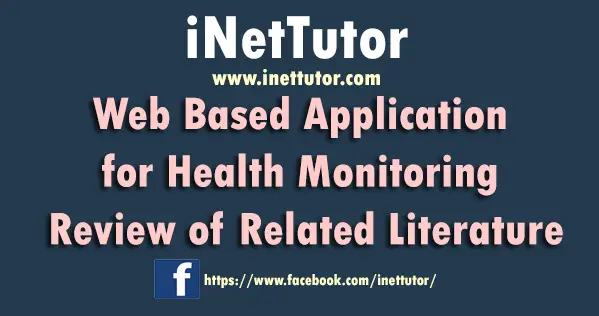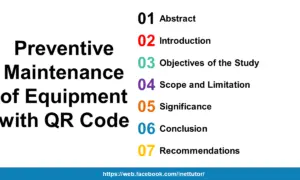Web Based Application for Health Monitoring Review of Related Literature
REVIEW OF RELATED LITERATURE
This chapter presents the related literature, related studies prior art and synthesis after the thorough and in-depth search done by the researchers.
According to the study of Brent Mittelstadt, Ben Fairweather, Mark Shaw, Neil McBride(2011). Personal Health Monitoring (PHM) technologies are currently being developed to supplement medical care environments with health monitoring outside “brick and mortar” settings. A primary factor spurring the development of PHM is the rapid aging of the global population which is predicted to increase the burdens placed on many countries’ healthcare systems, potentially outstripping available medical resources (Agree et al., 2005). Although the elderly are a primary force behind PHM, systems are currently in development for a multitude of audiences of all ages and health. This paper provides a review of the literature relating to the development and implementation of PHM technologies that discusses ethical issues. In the current literature agreement upon a common definition of “Personal Health Monitoring” does not exist, with many synonymous and related terms being used instead including “telecare,” “assistive technologies,” “ambient intelligence,” and “wearable health sensors”.

For the purposes of the current review a working definition was established that incorporates the related terms: Personal Health Monitoring refers to any electronic device or system that monitors a health-related aspect of a person’s life on a constant basis outside of a Hospital setting. Recently developed examples include GPS tracking devices used with mental health patients, blood pressure wrist monitors and “smart clothes” capable of Measuring physiological signs (Stergiou and Bliziotis, 2011, Lymberis, 2005, Lauriks et al.,2007). PHM devices may have the capability to record data both locally and offsite, or to register an alert in the case of abnormal activity. (www.academia.edu)
Monitoring health-related quality of life in paediatric practice: development of an innovative web-based application
Based on the studies of Lotte Haverman and et.al (2011) The use of Patient Reported Outcomes (PROs) in daily clinical practice is receiving increasing attention. PROs include the self-assessment of functional status, symptoms or other concerns, such as patient needs and satisfaction with care. Health Related Quality of Life (HRQOL) questionnaires are commonly used in clinical trials to collect information about a specific group of patients. These questionnaires retrieve information directly from the patient and are therefore a form of PRO. Today, HRQOL questionnaires are increasingly being used in daily clinical practice, being provided to the physician to facilitate communication with patients during a consultation. The majority of HRQOL studies focuses on oncology and reveals conflicting data in terms of effectiveness. Some adult studies suggest that discussing PROs improves communication between physicians and patients and facilitates early recognition of HRQOL problems. Physicians generally consider the use of PROs as a valuable addition to daily health care. Nevertheless, an improvement in patient satisfaction with care or an increase in scores is still challenging. This is due to methodological challenges, such as high baseline scores on patient satisfaction (ceiling effect ) or the nature of the study design. (www.ncbi.nlm.nih.gov)
Web-Based Integrated Public Healthcare Information System of Korea: Development and Performance
According to Seewon Ryu, PhD. and et.al (2013) The Web-based integrated public healthcare information system (PHIS) of Korea was planned and developed from 2005 to 2010, and it is being used in 3,501 regional health organizations. This paper introduces and discusses development and performance of the system. The integrated PHIS included 19 functional business areas, 47 detailed health programs, and 48 inter-organizational tasks. The new PHIS improved the efficiency and effectiveness of the business process and inter-organizational business, and enhanced user satisfaction. Economic benefits were obtained from five categories: labor, health education and monitoring, clinical information management, administration and civil service, and system maintenance.
The system was certified by a patent from the Korean Intellectual Property Office and accredited as an ISO 9001. It was also reviewed and received preliminary comments about its originality, advancement, and business applicability from the Patent Cooperation Treaty. It has been found to enhance the quality of policy decision-making about regional healthcare at the self-governing local government level. PHIS, a Web-based integrated system, has contributed to the improvement of regional healthcare services of Korea. However, when it comes to an appropriate evolution, the needs and changing environments of community-level healthcare service and IT infrastructure should be analyzed properly in advance.
Our goal was to identify precursor behaviors associated with specific medical conditions. We refer to the proposed solution as the Search Log Analysis for Precursor Behaviors (SLAPB) method, which involves a three-staged process. First, we identified a population of users who were likely to have a medical condition of interest as well as the date this was first acknowledged. Second, we generalized user queries into categories. Finally, we analyzed users’ query streams to find likely precursor behaviors. In the following, we describe the three stages. (www.ncbi.nlm.nih.gov)
Studies on Web Based Patient Support System for Health Monitoring and Quality of Life
According to Gayathri V Panicker and et.al (2014) Web-based Patient Support Systems (WPSS) are an emerging multidisciplinary research area in which one studies the support of human activities with the web as the common platform, medium and interface. One of the goals of WPSS research is to extend the human physical limitation of information processing. The availability, accessibility and flexibility of information as well as the tools to access this information lead to a vast amount of opportunities. It also examines how applications and adaptations of existing methodologies on the web platform benefit our decisionmaking and other various activities. This study proposes a web-based database system of patients’ information repository for effective and timely access to information when and where it is needed. The design uses the three-tier web model architecture as its underlying technology and presents an architectural design for a centralized information database system, which will save time in accessing patients’ health information and hence prompt healthcare delivery will be achieved for the health industries.(www.isaet.org)
HealthFace: A web-based remote monitoring interface for medical healthcare systems based on a wireless body area sensor network
According to Ismail KIRBAS and C¨uneyt BAYILMIS (2012) The wireless body area sensor network (WBASN) is a type of wireless sensor network. The wireless sensor nodes in a WBASN are placed on, near, or within a human body. In a medical healthcare system, WBASNs continuously provide healthcare monitoring, especially of elderly or ill people, wherever the patient goes. Wireless nodes sense and process human vital signs such as heart rate, blood pressure, body temperature, and respiration. They then send collected data to a medical center via a base station in order for medical professionals to monitor the patient’s health. In the medical center, doctors and caregivers need monitoring systems or interfaces to process, analyze, and visualize the received data from WBASN-based systems. In this paper, we present a web-based remote monitoring interface, HealthFace, for medical healthcare systems based on a WBASN. Users can easily access the developed HealthFace via any Internet-connected device, such as a PC, PDA, laptop, or cell phone, without needing any special software or programs except for a web browser. In addition, the implemented HealthFace presents several features, including recording, displaying, and analyzing collected data from the sensor nodes using MATLAB Builder NE with Web Figure. Web Figure enables users to utilize 3-dimensional view, zoom, and movement functions.
This paper presents a web-based remote monitoring interface, called HealthFace, using MATLAB Builder NE with Web Figure for WBASN-based medical healthcare systems in order to monitor the medical status of patients and the elderly. Users can easily access the developed interface via any device, such as a PC, laptop, PDA, or mobile phone connected to the Internet, without needing any special software or programs except for a web browser. The implemented HealthFace also provides several features, including the ability to record, analyze, and display collected data from sensor nodes. In addition, Web Figure enables beneficial visualization with 3-dimensional view, zoom, and movement for users. (www.journals.tubitak.gov)
Electronic patient records
According to this site (2011) Electronic patient records (EPRs) have been introduced in many countries in recent years. They have the potential to improve many aspects of clinical practice, including prescribing, patient follow-up, chronic disease management, and adherence to clinical guidelines. However, there are also potential challenges, including underestimation of time commitment by physicians, the need for expensive ongoing technical support, and concerns about the maintenance of patient confidentiality.
With increasing availability and reliability of Inter-net access globally, there is recognition that EPRs could also contribute significantly to improved patient care in resource-limited areas. Although there are practical problems with establishing EPR systems in such settings, many can be overcome simply, for example, through the use of solar batteries where power supplies are unreliable, or through limiting the number of computers networked to a web-based central database. Where computerized records are available, web-based systems have significant advantages over locally held patient databases, many of which rapidly become overwhelmed by large amounts of patient information and are user-unfriendly and unwieldy. Fraser et al reviewed a number of systems in use in Africa, and Central and South America, and described the benefits of such systems. These included:
- clear documentation of clinical notes
- reduced consultation and waiting times
- decision support for prescribing medications, including reminders, allergy warnings, and information about drug interactions
- alerts for abnormal laboratory results
- facilitation of data provision for national outcome monitoring.
Systems developed locally are often adaptable for use in other geographic areas. The eChasqui system, for example, was transferred successfully from Peru to the Philippines,26 and has subsequently been implemented in over 40 countries as the Open Medical Record System.
EPRs range from simple systems for storing locally entered patient data to more complex systems with links to other data sources relating to the patient, for example, digital radiology images, and laboratory and pharmacy information systems. In addition, they may facilitate other aspects of patient care, for example, through incorporation of clinical decision support. (www.ncbi.nlm.nih.gov)
Synthesis
The related literature and studies provides a great base on the proposal of Web-based Health System. There were a lot of related studies discussed the Web based application and Information System regarding the Health monitoring and also discussed the transition of manual system into the automated system. But the study aims to develop a web based health and welfare monitoring with medicine inventory, moreover the related studies will serve as the guidelines to the researchers on how to develop a system with the unique features which will help the Health Personnel and residents to monitor the all cases of disease.
Credits to the authors and developers of the project.
You may visit our Facebook page for more information, inquiries, and comments. Please subscribe also to our YouTube Channel to receive free capstone projects resources and computer programming tutorials.
Hire our team to do the project.


